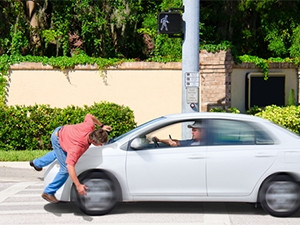
Although injuries resulting from texting and driving are usually more serious, injuries resulting from texting and walking occur more often.
This is according to a recent study by the New York-based Stoney Brook University; which revealed that distracted walkers often veer off course by as much as 61% while texting, live chatting, posting on Facebook, Twitter, or even playing games on their mobile phones.
What's more, the study found that the number of injuries caused by texting and walking may be higher than official figures indicate, since people are embarrassed to admit that they were injured while texting.
The worst culprits, according to the research, are young people between the ages of 18 and 34 and also women aged 55 and older. Bumping into walls, falling down the stairs tripping over clutter stepping into traffic are among the causes of some of the injuries they sustain while texting and walking.
According to another study published in Injury Prevention, people who text while walking took nearly two seconds longer than non-texters to cross three or four lanes of traffic.
The study estimates one in three people are distracted by mobile devices while crossing the street.
Advocate Johan Jonck, founder of SA's Arrive Alive campaign, says statistics relating to the number of South Africans who text and walk are unavailable due to a lack of transparency from pedestrians involved in accidents as a result of texting and walking.
"However, there has been concern from the public regarding deaf people who walk and text. Although there are no statistics to support this, deaf people may be the highest at risk because they don't hear any noises from motor vehicles and potential harm coming their way. This could prove hazardous to them.
"Some members of the public have called for legislation to be put in place which will prohibit deaf people from texting and walking", reveals Jonck.
"The number of pedestrian deaths in SA accounts for 35-40% of overall road fatalities. We have been recently alerting the public on our social media platforms of the dangers of texting and walking," he explains.
According to an Arrive Alive report, there are now more accidents taking place as a result of pedestrian inattentiveness while crossing the road. Pedestrians who attempt to multitask while either texting or talking on the phone have reduced cognitive capacity to devote to potentially dangerous activities such as crossing the streets.
The campaign says the rise in the use of personal electronics by pedestrians may be an ingredient for disaster.
Arrive Alive safety tips for pedestrians:
* Just as drivers should limit cellphone use while driving, pedestrians - and especially child pedestrians - should limit cellphone use while crossing streets.
* Pay attention to warnings from gadget manufacturers and mobile providers on the dangers of using their products while crossing roads.
* If you're going to talk on cellular phones, stay stationary.
* Don't walk while using mobile devices in traffic.
* Be fully aware of your surroundings - don't let music playing on your phone take your attention away from the sound of oncoming vehicles, hooting or sirens.
* Never assume that you have the right of way and that cars will stop for you.
Share